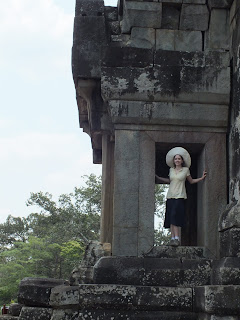Our third day at Angkor was also our most ambitious: after visiting three temples in the morning, we hit another three temples in the afternoon. As with each of our Angkor excursions, our agenda was determined by geography rather than chronology, so the day included examples from a variety of time periods in a variety of architectural styles.
Ta Nei
Ta Nei is a 12th-century temple built during the reign of Jayavarman VII. Ta Nei is among the least-visited sites in the Angkor complex: a small ruin tucked away deep in the forest, tricky to get to and extremely difficult to find. These are, of course, the temple's main attractions.
 |
| In case you couldn't tell, I can't get enough of these ruined towers! |
 |
| Action sequence in 3 . . . 2 . . . 1 . . . |
 |
| . . . go! |
 |
| This lintel used to depict Buddha and his devotees. (Remember, Jayavarman VII was the Buddhist king who built the Bayon, with all the Brahma-Buddha-Jayavarman faces.) But Buddha's head was chopped off sometime after Jayavarman's death, when there was a big Hindu backlash against Buddhist imagery. |
Ta Keo
Despite the similarity in their names, Ta Keo is pretty much the opposite of Ta Nei: much older, much larger, much more open, and in much better shape. Probably built sometime around 1000 AD, Ta Keo is a classic temple mountain - likely the first, in fact, to be built mostly of sandstone.
Ta Keo also has some of the steepest steps.
Overall, the charms of Ta Keo are more about architecture than interior decoration. In other words, the view is stunning from both the bottom and the top, but a lot of the carvings are in pretty poor shape.
 |
| Forest, as far as the eye can see. |
Chau Say Tevoda
Chau Say Tevoda was built in the mid-12th century, during the reign of Suryavarman II, the guy who built Angkor Wat itself. Like Angkor Wat, it exhibits a kind of classical simplicity, especially when compared to the more chaotic temples of Jayavarman VII.
Chau Say Tevoda only reopened to the public in 2009, after a lengthy restoration project led by the Chinese. This is awesome for two reasons: it still hasn't made it back into the rotation for most of the big tour groups, and the restored carvings are in fantastic shape.
 |
| All together now: Vishnu on Garuda. |






















No comments:
Post a Comment